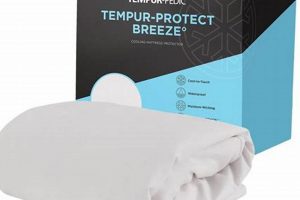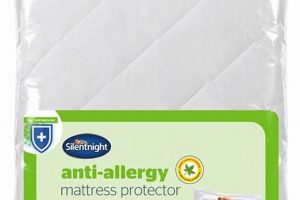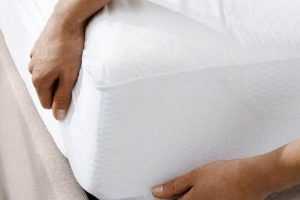The frequency with which a mattress encasement requires laundering is a key consideration for maintaining a hygienic sleep environment. This maintenance schedule depends on factors such as usage, presence of pets, and individual susceptibility to allergens. Regular cleaning helps remove accumulated dust mites, dead skin cells, and other debris that can compromise air quality and contribute to allergic reactions.
Consistent upkeep extends the lifespan of both the protector and the underlying mattress, safeguarding against stains, spills, and potential damage. A clean barrier contributes to a healthier sleep space, promoting better respiratory health and reducing the potential for skin irritations. Historically, diligent household cleaning practices have always been associated with overall well-being, and this extends to the items protecting bedding.
Guidelines for determining a practical laundering schedule are influenced by several factors, including protector material, usage patterns, and environmental conditions. This article will delve into the specifics of establishing an appropriate cleaning routine, considering various needs and circumstances to optimize the effectiveness of this protective layer.
Tips for Maintaining a Clean Mattress Encasement
Adhering to a regular maintenance schedule is crucial for preserving the integrity and hygiene of the bed’s protective barrier. The following guidelines offer practical advice on establishing an effective cleaning routine.
Tip 1: Establish a Consistent Schedule: A washing routine should be established based on individual needs and circumstances. A monthly cleaning is generally recommended for most households. However, if allergens are a concern or pets share the bed, more frequent laundering, such as every two weeks, may be necessary.
Tip 2: Consider the Material: The fabric composition of the protector dictates the appropriate washing method. Always consult the manufacturer’s care instructions before laundering. Cotton or polyester protectors can typically be machine washed, while delicate materials may require hand washing or professional cleaning.
Tip 3: Pre-Treat Stains Promptly: Address stains immediately to prevent them from setting into the fabric. Use a mild stain remover appropriate for the material and follow the product’s instructions carefully. Avoid harsh chemicals that can damage the protector’s water-resistant or hypoallergenic properties.
Tip 4: Use a Gentle Detergent: Opt for a mild, hypoallergenic detergent to minimize the risk of allergic reactions and protect the fabric’s integrity. Avoid using bleach or fabric softeners, as these can degrade the material and reduce its effectiveness.
Tip 5: Wash in Warm Water: Unless otherwise specified by the manufacturer, washing in warm water (approximately 30-40C) is generally effective for removing dirt and allergens without damaging the protector. Higher temperatures may be necessary for heavily soiled protectors, but proceed with caution.
Tip 6: Dry Thoroughly: Ensure the protector is completely dry before placing it back on the mattress to prevent mold and mildew growth. Tumble dry on a low setting or air dry in a well-ventilated area. Avoid using high heat, as this can shrink or damage the material.
Tip 7: Inspect Regularly: Routinely examine the protector for signs of wear and tear, such as rips, tears, or weakened seams. Repair or replace the protector as needed to maintain its protective function. A damaged protector cannot effectively safeguard the mattress.
Following these guidelines helps maintain the cleanliness and effectiveness of the mattress’s protective layer, contributing to a healthier and more hygienic sleep environment. Regular maintenance extends the protector’s lifespan and ensures optimal protection against allergens, spills, and stains.
With a clear understanding of these best practices, one can proceed to establish a personalized care schedule to maximize the lifespan and hygiene of bedding protection.
1. Monthly, generally adequate
The recommendation of a monthly washing schedule for mattress protectors serves as a baseline for maintaining a clean sleep environment. This frequency is often sufficient for individuals without specific sensitivities or high-risk exposures. However, several factors may necessitate adjustments to this standard guideline.
- Standard Household Hygiene
A monthly cleaning cycle aligns with general household cleaning practices, targeting the removal of accumulated dust, skin cells, and minor spills. This routine is typically adequate for individuals who maintain overall cleanliness in their bedrooms and do not experience significant allergen exposure. The objective is to prevent the buildup of irritants that could compromise sleep quality.
- Moderate Usage Conditions
For individuals who utilize their beds primarily for sleep and experience limited exposure to potential contaminants, a monthly washing schedule is generally adequate. This scenario assumes minimal pet contact, no chronic health conditions that produce excessive perspiration, and limited daytime use of the bed for activities that could introduce dirt or debris. Under these conditions, the mattress protector serves its intended function without requiring more frequent cleaning.
- Material Properties and Durability
Many mattress protectors are designed to withstand monthly washing cycles without significant degradation. Regular laundering helps maintain the protector’s water-resistant or hypoallergenic properties, prolonging its lifespan and ensuring continued effectiveness. A monthly schedule strikes a balance between hygiene and material preservation, preventing unnecessary wear and tear.
- Cost-Effectiveness and Convenience
A monthly washing frequency represents a reasonable compromise between hygiene maintenance and practical convenience. It minimizes the time and resources required for laundry while still providing adequate protection against common allergens and spills. This schedule aligns with the routines of many households, making it a sustainable and cost-effective approach to mattress protector care.
The “monthly, generally adequate” guideline functions as a starting point for determining an appropriate cleaning routine. However, individual circumstances, including health concerns, lifestyle factors, and the specific characteristics of the mattress protector, may necessitate adjustments to this baseline frequency. The goal is to establish a schedule that effectively balances hygiene, convenience, and the longevity of the protector and underlying mattress.
2. Allergies necessitate more frequent
The presence of allergies significantly impacts the recommended cleaning schedule for mattress protectors. A heightened sensitivity to allergens demands a more rigorous approach to maintaining a hygienic sleep environment, requiring adjustments to standard cleaning practices.
- Increased Allergen Accumulation
Individuals with allergies often experience heightened reactions to common household allergens such as dust mites, pet dander, and mold spores. These allergens can accumulate rapidly within bedding, including mattress protectors, triggering allergic symptoms. More frequent washing removes these accumulated allergens, reducing the potential for allergic reactions during sleep. For example, those with dust mite allergies may experience increased symptoms if the mattress protector is not washed regularly to eliminate mite populations and their waste products.
- Enhanced Exposure Pathways
Allergic individuals may exhibit behaviors that increase their exposure to allergens, such as spending more time in bed due to illness or working from home. This extended exposure elevates the concentration of allergens within the sleep environment, necessitating more frequent cleaning of the mattress protector. Children with allergies, who often spend more time playing on or near the bed, require more diligent maintenance of bedding hygiene.
- Compromised Immune Function
Allergies can compromise the immune system, making individuals more susceptible to other health issues. Reducing allergen exposure through frequent washing of the mattress protector helps alleviate the burden on the immune system, promoting overall health and well-being. Managing allergen levels in the sleeping environment can contribute to better respiratory health and reduce the incidence of secondary infections in allergy sufferers.
- Specific Allergen Considerations
The type of allergy influences the frequency of mattress protector washing. Individuals allergic to mold may require more frequent cleaning to prevent mold growth, especially in humid environments. Pet allergies necessitate regular washing to remove pet dander embedded within the protector. Tailoring the washing schedule to the specific allergen ensures optimal control of the sleep environment and minimizes allergic reactions. For instance, a person allergic to pollen might increase washing frequency during peak pollen seasons.
The need for more frequent mattress protector washing in allergic individuals is driven by increased allergen load, enhanced exposure pathways, compromised immune function, and specific allergen considerations. This proactive approach to bedding hygiene is crucial for mitigating allergic reactions and promoting a healthier sleep environment. Adherence to a more rigorous cleaning schedule directly correlates with improved symptom management and enhanced quality of life for allergy sufferers.
3. Spills warrant immediate washing
The necessity of immediate laundering following a spill directly overrides any pre-established schedule for mattress protector maintenance. This immediate action serves to prevent lasting damage, mitigate potential health hazards, and preserve the integrity of both the protector and the underlying mattress.
- Prevention of Stain Setting
Prompt cleaning following a spill prevents the stain from permanently setting into the fabric fibers of the mattress protector. Liquids, particularly those containing dyes or organic matter, can quickly permeate the material, causing discoloration that becomes increasingly difficult to remove over time. Immediate action minimizes this risk, preserving the aesthetic appeal of the bedding and avoiding the need for potentially damaging stain removal techniques. For instance, spilling coffee or red wine necessitates immediate attention to prevent permanent staining. Delayed action allows these substances to bind to the fabric, requiring more aggressive cleaning methods that could compromise the protector’s water-resistant properties.
- Mitigation of Microbial Growth
Spilled liquids, especially those containing sugar or organic matter, create an ideal environment for microbial growth, including bacteria and mold. These microorganisms thrive in moist conditions and can lead to unpleasant odors, fabric degradation, and potential health risks. Immediate washing eliminates the moisture and organic matter, preventing microbial proliferation. Failure to promptly address a spill of milk or juice, for example, can lead to rapid bacterial growth and the development of foul odors within the mattress protector. Timely laundering disrupts this process, maintaining a hygienic sleep environment.
- Preservation of Mattress Integrity
Mattress protectors are designed to shield the mattress from liquids and other contaminants. However, a prolonged spill can overwhelm the protector’s barrier, allowing liquids to seep through and damage the underlying mattress. Immediate cleaning of the protector minimizes the risk of liquid penetration, preserving the mattress’s condition and extending its lifespan. Neglecting a spill of urine or other bodily fluids can result in permanent damage to the mattress, rendering it unsanitary and potentially unusable. Prompt action safeguards the mattress from such damage, protecting the investment in the bedding.
- Prevention of Allergen Accumulation
Spills can introduce allergens or exacerbate existing allergen problems within the bedding. Liquid spills attract dust mites and other allergens, creating a breeding ground for these irritants. Immediate washing removes the spill and associated allergens, maintaining a clean and healthy sleep environment. A spill of pet saliva, for instance, can introduce pet dander into the mattress protector, triggering allergic reactions in sensitive individuals. Timely laundering eliminates the dander and prevents further allergen accumulation, promoting a more comfortable and allergy-free sleep experience.
Immediate laundering following a spill represents a critical deviation from any established mattress protector washing schedule. This proactive response serves to prevent stain setting, mitigate microbial growth, preserve mattress integrity, and minimize allergen accumulation. By prioritizing immediate action in the event of a spill, individuals can effectively maintain the cleanliness, hygiene, and longevity of their bedding.
4. Material care impacts frequency
The composition of a mattress protector’s fabric fundamentally influences the frequency with which it requires laundering. Different materials possess varying levels of durability, stain resistance, and compatibility with different cleaning methods, directly affecting the appropriate maintenance schedule.
- Cotton and Cotton Blends
Cotton and cotton-blend protectors are generally durable and can withstand frequent machine washing. However, cotton is susceptible to shrinking and may require lower temperature settings to prevent damage. Protectors made from these materials often necessitate more frequent washing due to their absorbent nature, particularly in cases of spills or heavy perspiration. Failure to adhere to recommended washing temperatures can lead to premature wear and reduced effectiveness.
- Polyester and Synthetic Fabrics
Polyester and other synthetic fabrics are typically more resistant to shrinking and fading compared to cotton. They often require less frequent washing due to their inherent stain resistance and quick-drying properties. However, high heat during washing or drying can damage synthetic fibers, diminishing their protective qualities. Adherence to specific care instructions is crucial to maintain the integrity of these protectors and prevent premature degradation.
- Waterproof Membranes (e.g., TPU, Polyurethane)
Mattress protectors featuring waterproof membranes require careful handling to avoid damaging the water-resistant layer. Harsh detergents, bleach, or high heat can compromise the membrane’s integrity, rendering it ineffective. Washing frequency should be minimized, and specialized cleaning agents may be necessary to preserve the waterproof function. Improper care can lead to cracking or delamination of the membrane, voiding the protector’s intended purpose.
- Specialty Fabrics (e.g., Bamboo, Wool)
Protectors made from specialty fabrics like bamboo or wool often require specific cleaning methods to maintain their unique properties. Bamboo is known for its antimicrobial and hypoallergenic qualities, but harsh chemicals can strip these benefits. Wool offers natural temperature regulation but is prone to shrinking and felting if not washed carefully. Consulting the manufacturer’s instructions is essential to avoid damaging these materials and ensure their longevity. Deviation from recommended care practices can compromise the fabric’s performance and reduce its lifespan.
In summary, the material composition of a mattress protector directly dictates the appropriate washing frequency and care methods. Consideration of the fabric’s properties is paramount to maintaining its protective qualities and extending its lifespan, ultimately influencing the effectiveness of the protector in maintaining a hygienic sleep environment. Neglecting these material-specific considerations can result in damage, reduced performance, and a shortened lifespan for the protector.
5. Usage affects cleaning schedule
The extent to which a mattress protector is utilized directly influences the regularity with which it should be laundered. Variations in usage patterns introduce differing levels of soiling, allergen accumulation, and general wear, necessitating adjustments to a standard cleaning regimen.
- Frequency of Bed Occupancy
A bed used nightly by one individual requires less frequent washing of the protector compared to a bed occupied by multiple individuals or used intermittently as a guest bed. Consistent, nightly use leads to a gradual buildup of skin cells, body oils, and dust mites. Infrequent usage may still result in allergen accumulation from dust and environmental factors, although at a slower rate. The number of occupants directly correlates with the rate of soiling, necessitating a more frequent cleaning schedule for heavily used beds. For instance, a child’s bed, often subject to spills and accidents, warrants more frequent laundering than an adult’s bed with minimal incidents.
- Activities Conducted on the Bed
Activities such as eating, reading with pets, or working from bed introduce additional contaminants and potential allergens to the mattress protector. Eating in bed increases the risk of spills and food particle accumulation, while allowing pets on the bed introduces pet dander and potential parasites. Working from bed can lead to the accumulation of dust and debris from clothing and surrounding surfaces. These activities necessitate more frequent washing to maintain a hygienic sleep environment. A bed primarily used for sleeping requires less frequent laundering compared to one used for a variety of activities that introduce external contaminants.
- Individual Health Conditions
Certain health conditions, such as night sweats, incontinence, or skin disorders, can significantly increase the rate of soiling of the mattress protector. Individuals experiencing night sweats produce excessive moisture that can promote microbial growth and necessitate more frequent laundering. Incontinence requires immediate and thorough cleaning to prevent staining and odor development. Skin disorders can lead to increased shedding of skin cells, requiring more frequent washing to maintain a clean sleep surface. These health-related factors necessitate a tailored cleaning schedule to address specific hygiene concerns.
- Environmental Factors
The surrounding environment can also influence the required cleaning frequency. Individuals living in humid climates or homes with poor ventilation may experience increased mold growth, necessitating more frequent washing to prevent allergen accumulation. Similarly, those living in areas with high levels of dust or pollen may need to launder the protector more often to remove these environmental contaminants. External factors contribute to the overall soiling rate, requiring adjustments to the cleaning schedule based on the specific environmental conditions. A mattress protector in a coastal environment may require more frequent washing due to increased humidity and salt exposure compared to one in a dry, inland climate.
These usage-related factors necessitate a dynamic approach to determining a suitable laundering schedule. The “how often should you wash mattress protector” guideline must be adapted to account for individual circumstances, lifestyle factors, and environmental conditions. A proactive approach to assessing usage patterns ensures that the cleaning schedule effectively addresses the specific hygiene needs of the sleep environment, promoting a healthier and more comfortable rest.
Frequently Asked Questions About Mattress Protector Maintenance
The following questions address common concerns and misconceptions regarding the proper care and maintenance of mattress protectors, offering clear and concise information for optimal hygiene and longevity.
Question 1: Is regular washing of a mattress protector truly necessary, or is it merely a matter of preference?
Regular laundering is not simply a matter of preference, but rather a crucial aspect of maintaining a hygienic sleep environment. It serves to eliminate accumulated allergens, dust mites, and body oils, contributing to both sleep quality and overall health. Neglecting this routine can lead to the proliferation of unwanted organisms and a degradation of the protector’s efficacy.
Question 2: What constitutes “regular washing” in the context of mattress protector maintenance?
The definition of “regular” depends upon individual circumstances. For most individuals, a monthly laundering schedule is adequate. However, those with allergies, pets, or heightened sensitivity to dust and allergens should consider a bi-weekly schedule. The immediate cleaning of spills is also considered a part of a regular schedule.
Question 3: Can improper washing techniques damage a mattress protector, and if so, how can such damage be prevented?
Improper washing techniques can indeed damage a mattress protector. The use of harsh chemicals, excessive heat, or abrasive cleaning methods can degrade the material and compromise its protective qualities. Adherence to the manufacturer’s care instructions is paramount to prevent such damage. This includes selecting appropriate detergents, water temperatures, and drying methods.
Question 4: Are all types of mattress protectors equally washable, or do certain materials require special handling?
Not all mattress protectors are equally washable. Protectors constructed from delicate materials, such as wool or specific synthetic blends, often require special handling. Some may necessitate hand washing or professional cleaning to prevent damage. Consulting the care label is essential to determine the appropriate cleaning method for a particular protector.
Question 5: What are the key indicators that a mattress protector requires immediate washing, regardless of the established schedule?
Several indicators signal the need for immediate laundering, irrespective of the established schedule. These include visible stains, spills, noticeable odors, and signs of allergen accumulation, such as increased allergy symptoms. Addressing these issues promptly prevents further degradation and maintains a hygienic sleep environment.
Question 6: Does the frequency of mattress protector washing impact its lifespan, and if so, how can this lifespan be maximized?
The frequency of laundering can influence a mattress protector’s lifespan. Excessive washing, particularly with harsh chemicals or high heat, can accelerate wear and tear. However, neglecting regular cleaning can also shorten its lifespan by allowing the accumulation of damaging substances. Striking a balance through adherence to the manufacturer’s care instructions and the use of gentle cleaning methods maximizes the protector’s lifespan.
Adherence to these guidelines, informed by a clear understanding of individual needs and the specific characteristics of the mattress protector, will promote optimal hygiene and prolong the lifespan of both the protector and the underlying mattress.
The next section will delve into the environmental impact of mattress protector cleaning and explore sustainable maintenance practices.
Determining Encasement Laundering Frequency
The preceding exploration clarifies that establishing a suitable laundering schedule for bedding protectors is a multifaceted endeavor. Factors such as presence of allergies, the occurrence of spills, material composition, and extent of usage contribute to the determination of an appropriate frequency. A rigid adherence to a single timetable is insufficient; rather, a dynamic assessment of individual needs and circumstances is paramount.
The commitment to consistent, informed maintenance practices ensures the longevity of the protector and the hygiene of the sleep environment. Neglecting these considerations can lead to compromised protection and potential health consequences. Therefore, a proactive approach to assessing cleaning requirements remains crucial for a clean and restful sleep.



![Best Malouf Mattress Protector [Guide & Review] Organic & Natural Mattress Buyer’s Guide: Non-Toxic Sleep Solutions Best Malouf Mattress Protector [Guide & Review] | Organic & Natural Mattress Buyer’s Guide: Non-Toxic Sleep Solutions](https://mattressworldpa.com/wp-content/uploads/2025/07/th-2531-300x200.jpg)
![Best Purple Protector Mattress: [Benefit] & Protection! Organic & Natural Mattress Buyer’s Guide: Non-Toxic Sleep Solutions Best Purple Protector Mattress: [Benefit] & Protection! | Organic & Natural Mattress Buyer’s Guide: Non-Toxic Sleep Solutions](https://mattressworldpa.com/wp-content/uploads/2025/07/th-2530-300x200.jpg)


